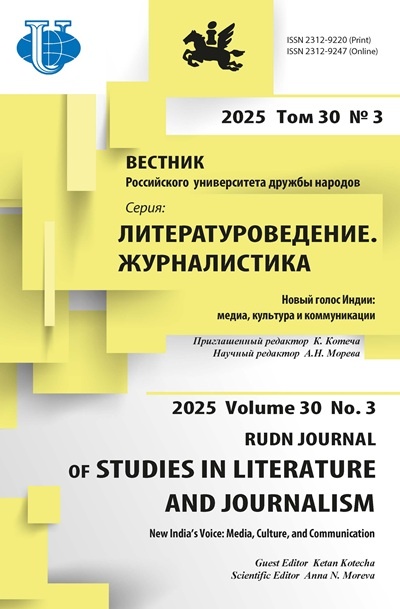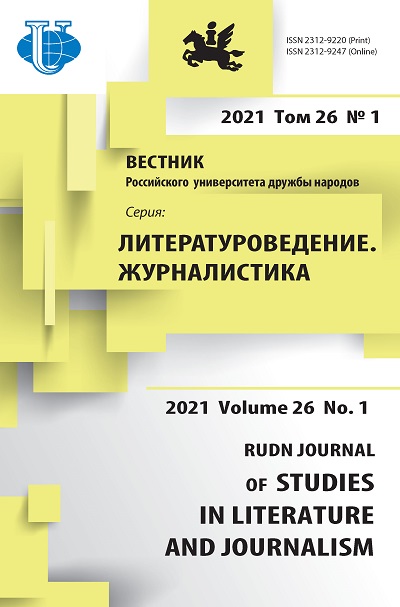Аффордансы информационно-коммуникационного универсума, или Кто стоит за спиной массмедиа
- Авторы: Дзялошинский И.М.1
-
Учреждения:
- Национальный исследовательский университет «Высшая школа экономики»
- Выпуск: Том 26, № 1 (2021)
- Страницы: 92-98
- Раздел: Журналистика
- URL: https://journals.rudn.ru/literary-criticism/article/view/26081
- DOI: https://doi.org/10.22363/2312-9220-2021-26-1-92-98
- ID: 26081
Цитировать
Полный текст
Аннотация
Рассматриваются особенности и перспективы теории информационно-коммуникационного универсума для анализа массмедиа. Целью является обоснование применения в контексте теории медиа понятия «аффорданс», которое психолог Джеймс Дж. Гибсон ввел в науку для обозначения специфического «приглашающего» характера объектов и событий, через аффордансы подсказывающих алгоритм последующих действий. С этой точки зрения информационно-коммуникационный универсум дает возможность, а иногда и приглашает использовать его для каких-то важных для субъектов коммуникации целей. Однако, как и в ситуации любых других аффордансов, качество и варианты реализации его возможностей зависят от целей, интересов и умений субъекта, который пытается с этим аффордансом работать. Проводя аналогию: кого-то топор «приглашает» наколоть дров для старушки, а кого-то - использовать его как орудие против нее же с целью завладеть пенсией. Выдвигается тезис о функциональной полезности категории «информационно-коммуникационный универсум» для анализа процессов в системе медиа: традиционные представления об особенностях производства и потребления текстов подвергаются коррекции. Анализируются аффордансы Интернета как подсистемы информационно-коммуникационного универсума, что позволяет объяснить радикальные расхождения в оценке сетевых цифровых технологий представителями разных исследовательских школ. Обозначены дальнейшие перспективы выявления и использования скрытых аффордансов.
Ключевые слова
Об авторах
Иосиф Михайлович Дзялошинский
Национальный исследовательский университет «Высшая школа экономики»
Автор, ответственный за переписку.
Email: idzyaloshinsky@hse.ru
доктор филологических наук, профессор-исследователь факультета коммуникаций, медиа и дизайна
Российская Федерация, 101000, Москва, Хитровский пер., д. 2/6, корп. 5Список литературы
- Пропп В.Я. Поэтика фольклора. М.: Лабиринт, 1998. 352 с.
- Анисимов А.В. Компьютерная лингвистика для всех: мифы, алгоритмы, язык. Киев: Наукова думка, 1991. 207 с.
- Симонов П.В. Созидающий мозг: нейробиологические основы творчества. М.: Наука, 1993. 111 с.
- Федотова С.Л. Тайные ураганы. Пермь, 2012.
- Рашкофф Д. Медиавирус. Как поп-культура тайно воздействует на ваше сознание. М.: Ультра. Культура, 2003. 368 с.
- Степин В.С. Саморазвивающиеся системы и постнеклассическая рациональность // Библиотека по философии. URL: http://filosof.historic.ru/books/item/f00/s00/z0000249/ (дата обращения: 19.08.2020).
- Zittrain J. The future of the Internet - and how to stop it. New Haven, CT; L.: Yale University Press, 2008.
- Zittrain J. The generative Internet // Harvard Law Review. 2005. Vol. 119. No. 7. URL: https://dash.harvard.edu/handle/1/9385626 (accessed: 12.03.2021).
- Асмолов Г.А., Асмолов А.Г. Интернет как генеративное пространство: историко-эволюционная перспектива // Вопросы психологии. 2019. № 4. С. 3-28.
- Асмолов Г.А., Асмолов А.Г. От Мы-медиа к Я-медиа: трансформация идентичности в виртуальном мире // Вопросы психологии. 2009. № 3. С. 3-15.
- Гибсон Дж. Экологический подход к зрительному восприятию. М.: Прогресс, 1988. 464 с.
- Норман Д. Дизайн вещей будущего. М.: Strelka Press, 2013. 224 с.
Дополнительные файлы















